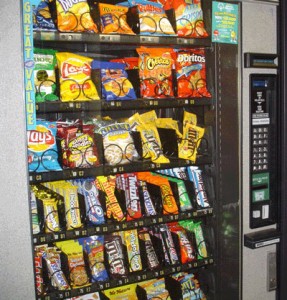The term “competitive foods” is used to describe the foods sold outside of the federal meal programs, typically foods that are found in vending machines. Many school districts have used income from vending machines to help fund school activities, but the foods are at cross purposes with healthy nutrition. Some states have passed laws restricting the availability of those items in schools. It appears, from this study that these laws have an effect.
Comparing their height, weight, and the food laws in the states found that when states passed strict laws regulating food and beverages five percent fewer students remained overweight, and eight percent fewer remain obese in the eighth grade than did states that did not enforce strict laws.
To translate the data: kids who are five foot tall gained 2 pounds more if they lived in a state that had no regulation of sugar filled drinks and snacks. States who passed laws that were effective had specific requirements that snacks have limited sugar and fat. Ineffective laws had no guidelines, and snacks available in those states still would be considered high in sugar. Currently, the United States Department of Agriculture (USDA) does place minimal limits only on the availability of foods of minimal nutritional value (FMNV) in food service areas during meal times. The Federal regulations allow states and local school districts to adopt stricter policies on access to competitive foods.
Some States limit access to all competitive foods, while others only limit access to FMNV, and others only limit access to soft drinks. Some laws apply to all schools, k-12, while other states only apply the laws from K-8. Some States prohibit specific channels of distribution or outlets for competitive items (e.g., vending machines or à la carte sales). Alabama prohibits sales of FMNV in all locations during meal service; New Jersey does not allow sales of FMNV on campus until the end of the last lunch period.
Since 20 percent of the elementary school children nationwide are considered obese, this small impact is important. In states without competitive food laws 37 percent of the fifth graders were overweight and 21 percent were obese. Contrast that with states that developed strict laws, where 39 percent of the fifth graders were overweight when the study began and dropped to 34% by eighth grade. The 21% of fifth graders who were obese in those states dropped to 18 percent.
This data is not conclusive, but does point out that if we eliminate one source of unhealthy foods from schools there is less obesity. This in spite of students being able to get unhealthy food when not in school. Should we regulate food sources for minors? It might just be necessary.
That reminds me: why do hospitals have junk food?
It is clear from our patients who have weight loss surgery: those who do not keep junk foods in their homes do better than those who allow them. Perhaps it is time to make our K-12 schools free from junk food.

Keeping Vending Machines off school grounds is an effective way to reduce obesity
REFERENCES:
Online from Pediatrics please click here.
